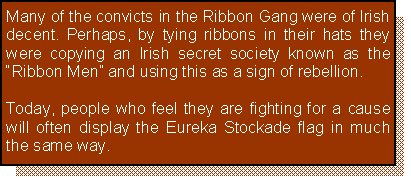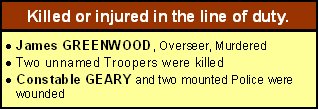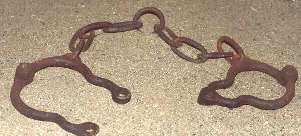|
|
Arrested for "Skinny Dipping"
On their return, they paused for a while beside the cool waters of the Macquarie River at Bathurst and decided to strip off and go for a swim. Unfortunately, they had chosen the wrong time and place to cool off!
The Governor, Ralph Darling, was in the area to inspect the new settlement of Bathurst and whilst the two convicts were enjoying their "skinny-dip" the Governor and a party of soldiers were about to cross the river.
Hoping not to be spotted, the two convicts hid amongst the reeds. After the soldiers had crossed, Entwistle and his mate came out from behind the reeds and began to get dressed. They had not noticed that there were two groups of soldiers and so were immediately arrested by the leader of the second group, who just happened to be the Bathurst Magistrate.
The charge was: "..causing an affront to the Governor and his party .." The sentence was a public flogging of 50 lashes of the whip!
This incident is a good illustration of the harshness of the times, when convicts were handed out severe punishment for relatively minor offences. This action, understandably, contributed to Entwistle becoming a very bitter man. This together with similar incidents let to the first major rebellion of convicts west of the Blue Mountains.
About nine months after the flogging, Entwistle induced a number of other convicts to take up arms and join him in the bush.
Entwistle Escapes
On September 23rd 1830, nine men, led by Entwistle escaped from their masters property and roamed the country side in the Fitzgeralds valley area, just south west of Bathurst. At each property that the "banditti" visited, they stole food, horses, guns and ammunition. One newspaper account mentioned that after only a short time the gang had stolen so much booty that it was getting too heavy to carry and had to be dumped.
The Rebellion Grows
The gang also "persuaded" other convicts to also escape and join the gang. In only two weeks the rebellion had grown.There were about 50 in the gang! (Although at least one Sydney newspaper was reporting a full scale rebellion of more than 500 escapees marauding around the bush!)
 One early newspaper report written by a local citizen of Bathurst, Mr. George Suttor, mentioned that the leader of the gang was wearing "a profusion of white streamers in his hat" and that "some call them the ribbon boys".
Overseer Murdered.
Early one morning the entire gang of fifty men turned up at the magistrates property (which is near the modern day village of Wimbledon), seeking revenge for the way that they had been treated as convicts. As the Magistrate was not on the property, the gang stormed up to the overseer's hut and demanded that all the convicts on the Magistrates property had to join the rebellion. The overseer was then shot and killed because he refused to allow any of his men to join.
Under threat of death, the convicts who belonged to the Magistrate also joined the gang, swelling the membership to about 130!
One early newspaper report written by a local citizen of Bathurst, Mr. George Suttor, mentioned that the leader of the gang was wearing "a profusion of white streamers in his hat" and that "some call them the ribbon boys".
Overseer Murdered.
Early one morning the entire gang of fifty men turned up at the magistrates property (which is near the modern day village of Wimbledon), seeking revenge for the way that they had been treated as convicts. As the Magistrate was not on the property, the gang stormed up to the overseer's hut and demanded that all the convicts on the Magistrates property had to join the rebellion. The overseer was then shot and killed because he refused to allow any of his men to join.
Under threat of death, the convicts who belonged to the Magistrate also joined the gang, swelling the membership to about 130!
 Gang Leaders find the Caves
Since many of those in the gang did not really want to be a part of the rebellion, from this point the gang began to fall apart. Entwistle and about 14 followers now split from the masses and called in at the Mulgunnia property (near Trunkey Creek) and stumbled on Grove Creek. They are believed to have followed the creek for a while and then quite by chance discovered the Abercrombie Archway. It is thought that the gang used Stable Arch for their horses. Gang Leaders find the Caves
Since many of those in the gang did not really want to be a part of the rebellion, from this point the gang began to fall apart. Entwistle and about 14 followers now split from the masses and called in at the Mulgunnia property (near Trunkey Creek) and stumbled on Grove Creek. They are believed to have followed the creek for a while and then quite by chance discovered the Abercrombie Archway. It is thought that the gang used Stable Arch for their horses.
Public meeting called in Bathurst
Meanwhile, back at Bathurst, a public meeting had been called at the Bathurst Courthouse to try and get some volunteers to help the six troopers who were stationed in the town. Twelve citizens came forward. The troopers also called for military re-enforcements.
The 39th Regiment were marched out from Sydney and the 48th Mounted Police were sent up from Goulburn.
After resting at the caves for a while, Entwistle and his men continued to follow Grove Creek until they got to the top of Grove Creek Falls. While they were camped there, looking for a way down, the Troopers and volunteers caught up with them.
 A battle took place at the top of the falls resulting in injuries on both sides and the gang loosing their horses.
The rebels retreated on foot, back to the caves, possibly hiding in Bushrangers Cave. A battle took place at the top of the falls resulting in injuries on both sides and the gang loosing their horses.
The rebels retreated on foot, back to the caves, possibly hiding in Bushrangers Cave.
 The attackers followed and on reaching the caves decided to search through the passages and flush out the criminals. It is thought that one of the Troopers who searched Bushrangers Cave, dropped a set of convict leg irons. Sixty-four years later, the first caretaker of the caves, Sam Grosvenor, discovered a set of leg-irons buried in the mud floor of Bushrangers Cave. These leg-irons are still on display at Abercrombie Caves.
Having escaped from the caves, the fugitives headed for the hills and at a spot now known as Bushrangers Hill, about 3 kilometres to the West of the caves, they encountered a group of soldiers. Although greatly outnumbered, the gang put up quite a fight, but were finally surrounded and arrested.
Tried and Hanged
Entwistle and his men were escorted back to Bathurst, where they were charged with murder, bushranging and horse-thieving. The trial was held by Special Commission led by Chief Justice Francis Forbes. The attackers followed and on reaching the caves decided to search through the passages and flush out the criminals. It is thought that one of the Troopers who searched Bushrangers Cave, dropped a set of convict leg irons. Sixty-four years later, the first caretaker of the caves, Sam Grosvenor, discovered a set of leg-irons buried in the mud floor of Bushrangers Cave. These leg-irons are still on display at Abercrombie Caves.
Having escaped from the caves, the fugitives headed for the hills and at a spot now known as Bushrangers Hill, about 3 kilometres to the West of the caves, they encountered a group of soldiers. Although greatly outnumbered, the gang put up quite a fight, but were finally surrounded and arrested.
Tried and Hanged
Entwistle and his men were escorted back to Bathurst, where they were charged with murder, bushranging and horse-thieving. The trial was held by Special Commission led by Chief Justice Francis Forbes.
 Of course, in those days, all of those offences carried the death penalty. On November 2nd 1830, ten members of the Ribbon Boys, which included Entwistle were hanged in Bathurst for their crimes. Another two had died of wounds before reaching Bathurst and a further three had even managed to escape capture. This was the first and largest public hanging in Bathurst. Of course, in those days, all of those offences carried the death penalty. On November 2nd 1830, ten members of the Ribbon Boys, which included Entwistle were hanged in Bathurst for their crimes. Another two had died of wounds before reaching Bathurst and a further three had even managed to escape capture. This was the first and largest public hanging in Bathurst. The site of the hanging is now marked by a lane in Bathurst known as "Ribbon Gang Lane". The site of the hanging is now marked by a lane in Bathurst known as "Ribbon Gang Lane".
|
SKINNY-DIPPING
Swimming Naked
TROOPERS
A Trooper was a member of an early form of Police force.
HUNG or HANGED?
Pictures are "Hung"
People are "Hanged" |


 Back in 1830, the Ribbon Gang Bushrangers used Abercrombie Caves as a safe place to hide. This was long before the more well known Bushrangers like Ben Hall or Ned Kelly were active.
Back in 1830, the Ribbon Gang Bushrangers used Abercrombie Caves as a safe place to hide. This was long before the more well known Bushrangers like Ben Hall or Ned Kelly were active.



 Gang Leaders find the Caves
Gang Leaders find the Caves
 A battle took place at the top of the falls resulting in injuries on both sides and the gang loosing their horses.
A battle took place at the top of the falls resulting in injuries on both sides and the gang loosing their horses.
 The attackers followed and on reaching the caves decided to search through the passages and flush out the criminals. It is thought that one of the Troopers who searched Bushrangers Cave, dropped a set of convict leg irons. Sixty-four years later, the first caretaker of the caves, Sam Grosvenor, discovered a set of leg-irons buried in the mud floor of Bushrangers Cave. These leg-irons are still on display at Abercrombie Caves.
The attackers followed and on reaching the caves decided to search through the passages and flush out the criminals. It is thought that one of the Troopers who searched Bushrangers Cave, dropped a set of convict leg irons. Sixty-four years later, the first caretaker of the caves, Sam Grosvenor, discovered a set of leg-irons buried in the mud floor of Bushrangers Cave. These leg-irons are still on display at Abercrombie Caves.
 Of course, in those days, all of those offences carried the death penalty. On November 2nd 1830, ten members of the Ribbon Boys, which included Entwistle were hanged in Bathurst for their crimes. Another two had died of wounds before reaching Bathurst and a further three had even managed to escape capture. This was the first and largest public hanging in Bathurst.
Of course, in those days, all of those offences carried the death penalty. On November 2nd 1830, ten members of the Ribbon Boys, which included Entwistle were hanged in Bathurst for their crimes. Another two had died of wounds before reaching Bathurst and a further three had even managed to escape capture. This was the first and largest public hanging in Bathurst. The site of the hanging is now marked by a lane in Bathurst known as "Ribbon Gang Lane".
The site of the hanging is now marked by a lane in Bathurst known as "Ribbon Gang Lane".